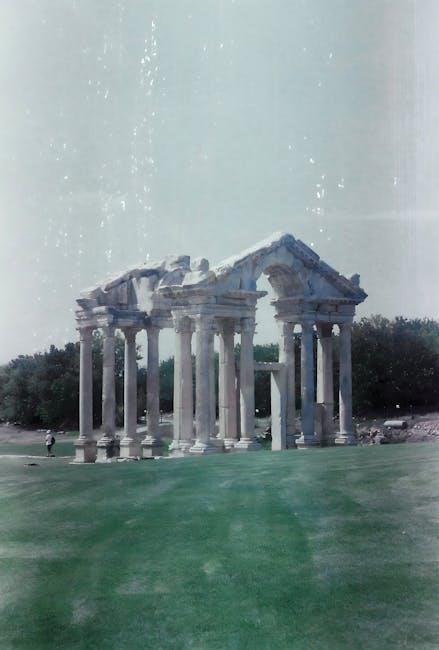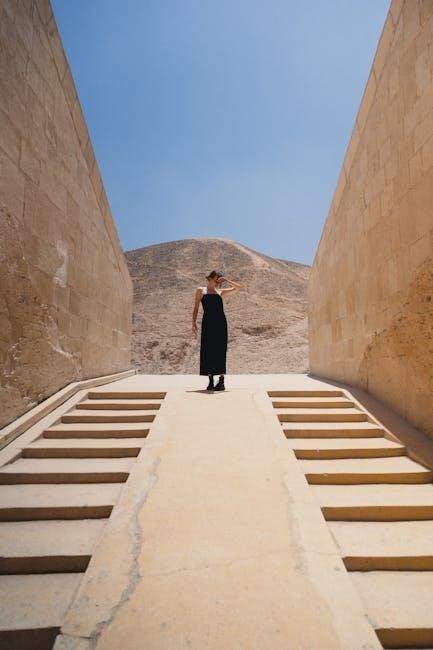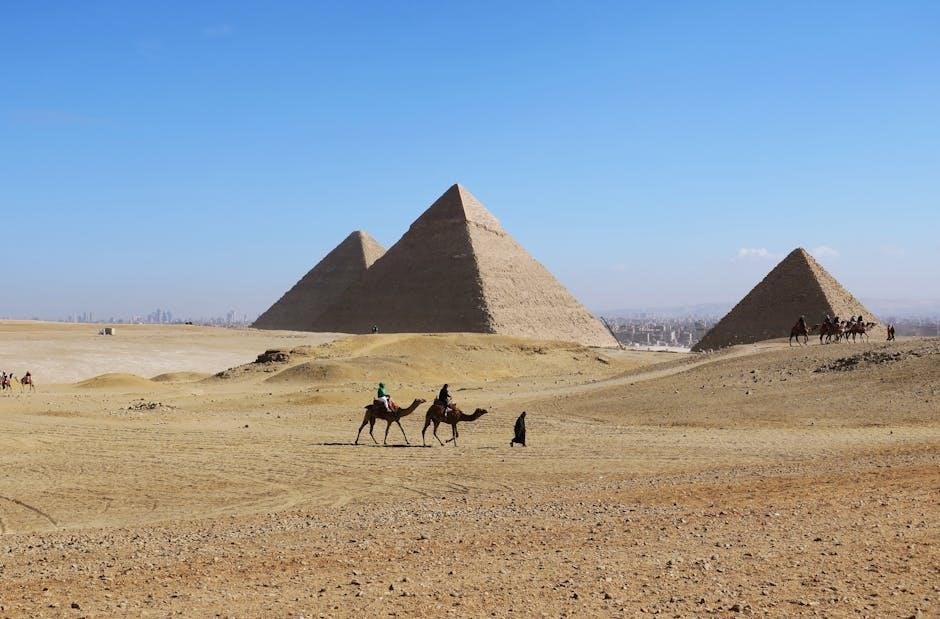Origin and Geographical Extent of the Indus Valley Civilization
The Indus Valley Civilization emerged along the Indus and Saraswati rivers, extending from Afghanistan to the Ganga-Yamuna Doab and from Jammu to the Tapti Valley. It was one of the earliest civilizations, alongside Egypt and Mesopotamia, and covered a vast geographical expanse.
1.1 The Indus and Saraswati River Valleys as the Cradle of Civilization
The Indus and Saraswati river valleys formed the nucleus of the civilization, providing fertile land and water resources. The Indus River, flowing through modern Pakistan, and the Saraswati, linked to the Ghaggar-Hakra system, supported agriculture and urbanization. These rivers facilitated trade and cultural integration, with cities like Mohenjo-Daro and Harappa thriving along their banks. The valleys’ unique hydrological features and seasonal flooding made them ideal for early settlers, laying the foundation for one of the world’s oldest urban societies.
1.2 Geographical Stretch: From Afghanistan to the Ganga-Yamuna Doab
The Indus Valley Civilization spanned a vast territory, extending from northeast Afghanistan to the Ganga-Yamuna Doab in the east and the Tapti Valley in the south. It also reached the Arabian Sea coast in the west. This extensive geographical stretch encompassed diverse regions, including modern-day Pakistan, northwest India, and parts of Afghanistan, highlighting the civilization’s expansive influence and adaptability across varied landscapes and river systems.

Chronology and Phases of Development
The Indus Valley Civilization evolved through distinct phases, from the Early Food Producing Era (7000-4000 BCE) to the Localization Era (1900-1300 BCE), marking its rise and decline.
2.1 Early Food Producing Era (7000-4000 BCE)
This era marked the transition from nomadic lifestyles to settled agriculture, with the domestication of wheat, barley, and animals like cattle and sheep. Early communities developed subsistence strategies, laying the foundation for later urbanization. Craft production emerged, and trade networks began to form, setting the stage for the civilization’s growth. This period was crucial for developing the agricultural and economic base that would support the rise of cities in subsequent phases.
2.2 Regionalization Era (4000-2600 BCE)

This period saw the diversification of pottery styles and the introduction of copper tools, marking early technological advancements. Regional trade networks expanded, and cultural practices became more distinct. Early signs of social complexity emerged, with the establishment of smaller settlements and the groundwork for future urban centers like Harappa. This era laid the foundation for the integration of various regional cultures into a cohesive civilization.
2.3 Integration Era (2600-1900 BCE)
This era marked the maturity of the Indus Valley Civilization, with the rise of urban centers like Harappa and Mohenjo-Daro. Cities featured grid layouts, advanced drainage systems, and monumental architecture. Trade networks expanded, and standardized seals and weights indicate a unified system. Craft specialization flourished, and cultural practices became more unified, reflecting a sophisticated urban society. This period is characterized by technological advancements and the peak of civic organization.
2.4 Localization Era (1900-1300 BCE)
This period saw the decline of major urban centers like Harappa and Mohenjo-Daro, with populations shifting to smaller settlements. Regional cultures emerged, and trade networks weakened. The once-unified system fragmented, leading to diverse local practices. Agricultural shifts and reduced monumental construction reflect a society in transition, marking the end of the Indus Valley Civilization’s urban phase and the beginning of a more decentralized way of life.

Urban Planning and Architecture

The Indus Valley Civilization is renowned for its advanced urban planning and architecture, featuring grid layouts, well-organized streets, and standardized construction, with elaborate drainage systems.
3.1 Layout and Infrastructure of Cities like Mohenjo-Daro and Harappa
The cities of Mohenjo-Daro and Harappa were meticulously planned with grid layouts, broad streets, and standardized brick construction. They featured advanced drainage systems, public baths, and granaries, reflecting sophisticated urban infrastructure. Private and public buildings were well-organized, with emphasis on hygiene and communal spaces. The use of baked bricks and drainage networks highlights the civilization’s engineering prowess, showcasing a high level of urban planning and architectural advancement for its time.
3.2 Advanced Drainage Systems and Urban Architecture
The Indus Valley Civilization showcased remarkable engineering with its advanced drainage systems, featuring covered drains, public wells, and sewage networks. Cities like Mohenjo-Daro had sophisticated urban architecture, with standardized baked bricks and well-planned structures. The integration of drainage systems with urban design emphasized hygiene and efficiency. These innovations highlight the civilization’s mastery of water management and urban planning, supporting a large population and showcasing a high level of technological sophistication for its time.

Economy and Trade
The Indus Valley Civilization had a thriving economy based on agriculture, trade, and specialized crafts. Trade networks extended regionally and internationally, exchanging goods like grains, metals, and pottery.
4.1 Agricultural Practices and Trade Networks
The Indus Valley Civilization relied heavily on agriculture, with crops like wheat, barley, and rice being central to their economy. The fertile plains of the Indus and Saraswati rivers supported surplus production, enabling trade. Extensive trade networks existed both regionally and internationally, with goods such as grains, metals, and pottery being exchanged. This economic prosperity facilitated the growth of specialized crafts and urban centers, showcasing a well-organized and interconnected society.
4.2 Crafts and Specialized Industries
The Indus Valley Civilization excelled in various crafts, including pottery, bead-making, and metallurgy. Artisans produced intricate pottery with geometric designs and seals featuring animal motifs. Bead production was highly specialized, using materials like carnelian and lapis lazuli. Metalworkers crafted tools and jewelry from copper, bronze, and gold. These industries, supported by advanced techniques, contributed to the civilization’s economic prosperity and cultural identity, reflecting a high level of skill and organization.
Social and Religious Life
The Indus Valley Civilization was a sophisticated society with a structured social hierarchy and religious practices. Rituals and symbols, like the Pashupati seal, indicate a deep spiritual life.
5.1 Social Stratification and Cultural Practices
The Indus Valley Civilization exhibited a clear social hierarchy, with elites residing in larger houses and laborers in smaller ones. Burial practices varied, indicating differences in status and wealth.
Cultural practices included advanced craftsmanship, trade networks, and communal infrastructure. Public buildings and drainage systems reflect a well-organized society, emphasizing hygiene and community welfare.
5.2 Religious Symbols and Rituals
The Indus Valley Civilization featured religious symbols like the Pashupati seal, depicting a deity surrounded by animals. Rituals likely involved fire altars and ceremonial vessels. The presence of cultic objects and seals with spiritual motifs suggests a formal religious system. These elements highlight the civilization’s spiritual practices and their integration into daily life, reflecting a sophisticated religious culture.
Technological Advancements
The Indus Valley Civilization excelled in metallurgy and water management, with advanced tools and hydraulic engineering supporting agriculture and urban life, showcasing their technical prowess and innovation.
6.1 Metallurgy and Tool Production
The Indus Valley Civilization demonstrated advanced metallurgical skills, crafting tools from copper, bronze, and gold. They produced intricate implements like blades, axes, and jewelry, showcasing their technical expertise and resourcefulness in metalworking.
6.2 Water Management and Hydraulic Engineering
The Indus Valley Civilization excelled in water management and hydraulic engineering, with sophisticated drainage systems and wells. Their advanced urban planning included intricate networks for water supply and waste removal, showcasing remarkable engineering skills. Irrigation systems supported agriculture, while seasonal flooding from rivers like the Ghaggar-Hakra enabled fertile farming. These innovations highlight their ability to adapt to and manage their environment effectively.
Decline and Legacy
The civilization declined due to climate change and river shifts, but its urban planning and cultural practices left a lasting legacy in South Asia.
7.1 Theories on the Decline of the Civilization
The decline of the Indus Valley Civilization (around 1900 BCE) is linked to climate change, river shifts, and tectonic movements. The drying of the Ghaggar-Hakra river and reduced monsoon rains disrupted agriculture. Urban centers were abandoned, and trade networks collapsed, leading to societal fragmentation. Environmental degradation and resource scarcity likely accelerated the decline, marking the end of this advanced Bronze Age civilization.
7.2 Lasting Impact on South Asian Culture
The Indus Valley Civilization left a profound legacy in South Asia, influencing urban planning, trade, and cultural practices. Its advanced town planning and craftsmanship inspired future societies. The civilization’s emphasis on hygiene and architecture is evident in later South Asian designs. Artistic and religious symbols, such as the Swastika and Pipal tree motifs, persisted in regional traditions. Its contributions shaped the cultural and social fabric of the subcontinent for millennia.
Recent Research and Discoveries
Recent studies reveal domesticated rice farming in South Asia began earlier than previously believed, with climate change impacting the civilization’s decline. New archaeological findings expand our understanding of its spread and technological advancements.
8.1 New Findings on Domesticated Rice Farming
Recent archaeological discoveries reveal that domesticated rice farming in South Asia began around 6000 years ago, far earlier than previously believed. This challenges conventional timelines, which dated its origins to 5000 years ago. Advanced research techniques confirm rice cultivation was widespread during the Indus Valley Civilization, indicating a significant shift in agricultural practices. These findings provide new insights into the civilization’s subsistence strategies and their role in shaping early South Asian societies.
8.2 Climate Change and Its Effects on the Civilization
Research indicates that climate change significantly impacted the Indus Valley Civilization, particularly after 3000 BCE. Weakening monsoon rains and reduced water flow in the Ghaggar-Hakra river system affected agriculture. The Indus River’s discharge decreased, while desertification expanded, altering the environment. These changes likely contributed to urban decline and societal restructuring, as evidenced by abandoned cities and shifts in settlement patterns, highlighting the civilization’s vulnerability to environmental shifts.